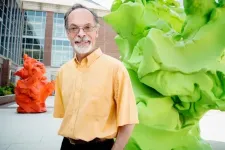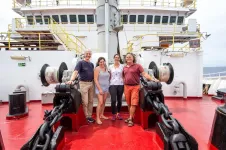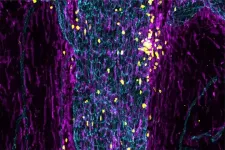Parkinson's disease risk and severity is tied to a channel in cells' 'recycling centers
2021-01-27
Many genetic mutations have been found to be associated with a person's risk of developing Parkinson's disease. Yet for most of these variants, the mechanism through which they act remains unclear.
Now a new study in Nature led by a team from the University of Pennsylvania has revealed how two different variations--one that increases disease risk and leads to more severe disease in people who develop Parkinson's and another that reduces risk--manifest in the body.
The work, led by Dejian Ren, a professor in the School of Arts & Sciences' Department of Biology, showed that the variation that raises disease risk, which about 17% of people possess, causes a reduction in function of an ion channel ...
Research finds blood pressure can be controlled without drugs after spinal cord injury
2021-01-27
Dr. Richi Gill, MD, is back at work, able to enjoy time with his family in the evening and get a good night's sleep, thanks to research. Three years ago, Gill broke his neck in a boogie board accident while on vacation with his young family. Getting mobile again with the use of a wheelchair is the first thing, Gill says, most people notice. However, for those with a spinal cord injury (SCI), what is happening inside the body also severely affects their quality of life.
"What many people don't realize is that a spinal cord injury prevents some systems within the body from regulating automatically," ...
Vaccine delivered via skin could help in fight against respiratory diseases
2021-01-27
Among infectious diseases that have caused pandemics and epidemics, smallpox stands out as a success story. Smallpox vaccination led to the disease's eradication in the twentieth century. Until very recently, smallpox vaccine was delivered using a technique known as skin scarification (s.s.), in which the skin is repeatedly scratched with a needle before a solution of the vaccine is applied. Almost all other vaccines today are delivered via intramuscular injection, with a needle going directly into the muscle, or through subcutaneous injection to the layer of tissue beneath the skin. But Thomas Kupper, MD, chair of the Department of Dermatology, and colleagues, had reason to suspect that vaccines delivered ...
Global analysis suggests COVID-19 is seasonal
2021-01-27
URBANA, Ill. - With cities around the globe locking down yet again amid soaring COVID-19 numbers, could seasonality be partially to blame? New research from the University of Illinois says yes.
In a paper published in Evolutionary Bioinformatics, Illinois researchers show COVID-19 cases and mortality rates, among other epidemiological metrics, are significantly correlated with temperature and latitude across 221 countries.
"One conclusion is that the disease may be seasonal, like the flu. This is very relevant to what we should expect from now on after the vaccine controls these first waves of COVID-19," says Gustavo ...
Geological phenomenon widening the Atlantic Ocean
2021-01-27
An upsurge of matter from deep beneath the Earth's crust could be pushing the continents of North and South America further apart from Europe and Africa, new research has found.
The plates attached to the Americas are moving apart from those attached to Europe and Africa by four centimetres per year. In between these continents lies the Mid-Atlantic Ridge, a site where new plates are formed and a dividing line between plates moving to the west and those moving to the east; beneath this ridge, material rises to replace the space left by the plates as they move apart.
Conventional wisdom is that this process is normally driven by distant gravity forces as denser parts of the plates sink back into the Earth. However, the driving force behind the separation of the Atlantic ...
Important climate change mystery solved by scientists
2021-01-27
Scientists have resolved a key climate change mystery, showing that the annual global temperature today is the warmest of the past 10,000 years - contrary to recent research, according to a Rutgers-led study in the journal Nature.
The long-standing mystery is called the "Holocene temperature conundrum," with some skeptics contending that climate model predictions of future warming must be wrong. The scientists say their findings will challenge long-held views on the temperature history in the Holocene era, which began about 12,000 years ago.
"Our reconstruction shows that the first half of the Holocene was colder than in industrial times due to the cooling effects of remnant ice sheets from the previous glacial period - contrary to previous reconstructions of global temperatures," ...
Top 10 insights in climate science in 2020 selected by 57 leading global researchers
2021-01-27
STOCKHOLM: With impacts from climate change threatening to be as abrupt and far-reaching in the coming years as the current pandemic, leading scientists have released a compilation of the 10 most important insights on the climate from the last year to help inform collective action on the ongoing climate crisis.
In a report presented today to Patricia Espinosa, Executive Secretary of the United Nations Framework Convention on Climate Change (UNFCCC), report authors outlined some of 2020's most important findings within the field of climate science, ranging from improved models that reveal the need for aggressive emission cuts in order to meet the Paris Agreement to the growing use of human rights litigation to catalyze climate action.
The report alleviates some worries that ...
Size of helium nucleus measured more precisely than ever before
2021-01-27
In experiments at the Paul Scherrer Institute PSI, an international research collaboration has measured the radius of the atomic nucleus of helium five times more precisely than ever before. With the aid of the new value, fundamental physical theories can be tested and natural constants can be determined even more precisely. For their measurements, the researchers needed muons - these particles are similar to electrons but are around 200 times heavier. PSI is the only research site in the world where enough so-called low-energy muons are produced for such experiments. The researchers are publishing their results today in the journal Nature.
After hydrogen, helium is the second most abundant element in the universe. Around one-fourth of the ...
Schizophrenia second only to age as greatest risk factor for COVID-19 death
2021-01-27
People with schizophrenia, a mental disorder that affects mood and perception of reality, are almost three times more likely to die from the coronavirus than those without the psychiatric illness, a new study shows. Their higher risk, the investigators say, cannot be explained by other factors that often accompany serious mental health disorders, such as higher rates of heart disease, diabetes, and smoking.
Led by researchers at NYU Grossman School of Medicine, the investigation showed that schizophrenia is by far the biggest risk factor (2.7 times increased odds of dying) after ...
'Virtual anatomy' imaging yields new insight into ancient platypus fish
2021-01-27
The inner ear of a 400 million-year-old 'platypus fish' has yielded new insights into early vertebrate evolution, suggesting this ancient creature may be more closely related to modern-day sharks and bony fish than previously thought.
A team of scientists from the University of Birmingham in the UK, and institutions in China, Australia and Sweden, used 'virtual anatomy' techniques, including MicroCT scanning (using x-rays to look inside the fossil) and digital reconstruction to examine previously unseen areas within the braincase of these mysterious fossils.
They discovered the fish, called ...
Scientists identify individual neurons responsible for complex social reasoning in humans
2021-01-27
BOSTON -- For the first time, scientists have identified the individual neurons critical to human social reasoning, a cognitive process that requires us to acknowledge and predict others' hidden beliefs and thoughts. A team of neuroscientists at Massachusetts General Hospital (MGH) and Massachusetts Institute of Technology (MIT) had a rare look at how individual neurons represent the beliefs of others by recording neuron activity in patients undergoing neurosurgery to alleviate symptoms of motor disorders such as Parkinson's disease. Their findings are published in Nature.
The researchers were studying a very complex social cognitive ...
Conditions among patients with COVID-19 four months after hospital discharge
2021-01-27
What The Study Did: This study among patients in Italy suggests that despite virological recovery, a sizable proportion of patients with COVID-19 experienced respiratory, functional or psychological conditions months after hospital discharge.
Authors: Mattia Bellan, M.D., Ph.D., of Università del Piemonte Orientale in Novara, Italy, is the corresponding author.
To access the embargoed study: Visit our For The Media website at this link https://media.jamanetwork.com/
(doi:10.1001/jamanetworkopen.2020.36142)
Editor's ...
Association of psychiatric disorders with mortality among patients with COVID-19
2021-01-27
What The Study Did: In this observational study of about 7,300 adults with laboratory-confirmed COVID-19 in a New York health system, a schizophrenia spectrum diagnosis was associated with an increased risk of death after adjusting for demographic and medical risk factors. Mood and anxiety disorders weren't associated with increased risk of mortality.
Authors: Donald C. Goff, M.D., of New York University Langone Medical Center in New York, is the corresponding author.
To access the embargoed study: Visit our For The Media website at this link https://media.jamanetwork.com/
(doi:10.1001/jamapsychiatry.2020.4442)
Editor's Note: The article includes conflict of interest disclosures. Please see ...
Examining oncology clinical trials launched before, during COVID-19 pandemic
2021-01-27
What The Study Did: Researchers evaluated the association between the pandemic and clinical research and development by studying the initiation of oncology clinical trials over time.
Authors: Elizabeth B. Lamont, M.D., M.S., M.MSc., of Acorn AI by Medidata, a Dassault Systèmes Company, in Boston, is the corresponding author.
To access the embargoed study: Visit our For The Media website at this link https://media.jamanetwork.com/
(doi:10.1001/jamanetworkopen.2020.36353)
Editor's Note: The article includes conflict of interest disclosures. Please see the article for additional information, including other authors, author contributions and affiliations, conflict of interest and financial ...
New findings on devonian 'platypus fish' cast light on evolution of modern jawed vertebrates
2021-01-27
New findings on the brain and inner ear cavity of a 400-million-year-old platypus-like fish cast light on the evolution of modern jawed vertebrates, according to a study led by Dr. ZHU Youan and Dr. LU Jing from the Institute of Vertebrate Paleontology and Paleoanthropology (IVPP) of the Chinese Academy of Sciences.
The study was published in Current Biology on Jan 27.
Back in 1960s, Paleontologist Dr. Gavin C. Young found several fossils of a long-beaked fish, a type of placoderm, in the Burrinjuck limestones in Australia. He named the fish Brindabellaspis stensioi, and other people jokingly dubbed it "platypus fish" because of its long ...
How does the immune system keep tabs on the brain?
2021-01-27
Alzheimer's disease, multiple sclerosis, autism, schizophrenia and many other neurological and psychiatric conditions have been linked to inflammation in the brain. There's growing evidence that immune cells and molecules play a key role in normal brain development and function as well. But at the core of the burgeoning field of neuroimmunology lies a mystery: How does the immune system even know what's happening in the brain? Generations of students have been taught that the brain is immunoprivileged, meaning the immune system largely steers clear of it.
Now, researchers at Washington University School of Medicine in St. Louis believe they have figured out how the immune system keeps tabs on what's going on in the brain. Immune ...
A new study reveals an "Achilles heel" of cancer cells
2021-01-27
What makes cancer cells different from ordinary cells in our bodies? Can these differences be used to strike at them and paralyze their activity? This basic question has bothered cancer researchers since the mid-19th century. The search for unique characteristics of cancer cells is a building block of modern cancer research. A new study led by researchers from Tel Aviv University shows, for the first time, how an abnormal number of chromosomes (aneuploidy) -- a unique characteristic of cancer cells that researchers have known about for decades -- could become a weak ...
Key switchgrass genes identified, which could mean better biofuels ahead
2021-01-27
Biologists believe they are one step closer to a long-held goal of making a cheap, widely available plant a source for energy and fuel, meaning one of the next big weapons in the battle against climate change may be able to trace its roots to the side of a Texas highway.
Researchers at The University of Texas at Austin, HudsonAlpha Institute for Biotechnology, the U.S. Department of Energy (DOE) and other institutions have published a complex genome analysis of switchgrass, a promising biofuel crop.
The team tied different genes to better performance in varying climates across North America, which now gives scientists a road map for breeding ...
Antibody highs and lows in survivors of Ebola
2021-01-27
A high proportion of survivors of Ebola experienced a resurgence in antibody levels nearly a year after recovery, a new University of Liverpool study has found.
Published today in Nature, the finding hints that hidden reservoirs of virus could exist long after symptoms ease and has implications for monitoring programmes and vaccine strategies.
When a person is infected with Ebola virus, their body produces antibodies to fight the disease. Antibody concentrations peak and then decline slowly over time, providing the body with some degree of immune protection ...
Scientists discover a new promising target for diabetes treatment
2021-01-27
Researchers have discovered a novel and druggable insulin inhibitory receptor, named inceptor. The latest study from Helmholtz Zentrum Muenchen, the Technical University of Munich and the German Center for Diabetes Research is a significant milestone for diabetes research as the scientific community celebrates 100 years of insulin and 50 years of insulin receptor discovery. The blocking of inceptor function leads to an increased sensitisation of the insulin signaling pathway in pancreatic beta cells. This might allow protection and regeneration of beta cells for diabetes remission.
Diabetes mellitus is a complex disease characterized by the loss or dysfunction of insulin-producing beta cells in the islets of Langerhans, ...
Well connected through amides
2021-01-27
Linking molecular components through amide bonds is one of the most important reactions in research and the chemical industry. In the journal Angewandte Chemie, scientists have now introduced a new type of reaction for making amide bonds. Called an ASHA ligation, this reaction is fast, efficient, works under mild aqueous conditions, and is broadly applicable.
Amide bonds are the bond between a carbonyl carbon (C=O) and an organic nitrogen atom. It is amide bonds that link individual amino acids together into proteins and bind monomers into polyamide plastics like perlon ...
Findings may help close door on COVID-19
2021-01-27
Researchers at Vanderbilt University Medical Center (VUMC) and the University of Texas Medical Branch (UTMB) at Galveston have discovered what may be the Achilles' heel of the coronavirus, a finding that may help close the door on COVID-19 and possibly head off future pandemics.
The coronavirus is an RNA virus that has, in its enzymatic toolkit, a "proofreading" exoribonuclease, called nsp14-ExoN, which can correct errors in the RNA sequence that occur during replication, when copies of the virus are generated.
Using cutting-edge technologies and novel bioinformatics approaches, the researchers discovered that this ExoN also regulates the rate of recombination, the ability of the coronavirus ...
Getting to net zero -- and even net negative -- is surprisingly feasible, and affordable
2021-01-27
Reaching zero net emissions of carbon dioxide from energy and industry by 2050 can be accomplished by rebuilding U.S. energy infrastructure to run primarily on renewable energy, at a net cost of about $1 per person per day, according to new research published by the Department of Energy's Lawrence Berkeley National Laboratory (Berkeley Lab), the University of San Francisco (USF), and the consulting firm Evolved Energy Research.
The researchers created a detailed model of the entire U.S. energy and industrial system to produce the first detailed, peer-reviewed study of how to achieve carbon-neutrality by 2050. According to the Intergovernmental Panel on Climate Change (IPCC), the world must reach zero net CO2 ...
Culture shapes willingness to share personal data to reduce COVID-19 spread
2021-01-27
CHAMPAIGN, Ill. -- Culture, civic-mindedness and privacy concerns influence how willing people are to share personal location information to help stem the transmission of COVID-19 in their communities, a new study finds. Such sharing includes giving public health authorities access to their geographic information via data gathered from phone calls, mobile apps, credit card purchases, wristband trackers or other technologies.
Reported in the International Journal of Geo-Information, the study will help public health officials better tailor their COVID-19 mitigation strategies to specific cultural contexts, the ...
More than just CO2: It's time to tackle short-lived climate-forcing pollutants
2021-01-27
Climate change mitigation is about more than just CO2. So-called "short-lived climate-forcing pollutants" such as soot, methane, and tropospheric ozone all have harmful effects. Climate policy should be guided by a clearer understanding of their differentiated impacts.
It is common practice in climate policy to bundle the climate warming pollutants together and express their total effects in terms of "CO2 equivalence". This 'equivalence' is based on a comparison of climate effects on a 100-year timescale. This approach is problematic, as IASS scientist Kathleen ...
[1] ... [2592]
[2593]
[2594]
[2595]
[2596]
[2597]
[2598]
[2599]
2600
[2601]
[2602]
[2603]
[2604]
[2605]
[2606]
[2607]
[2608]
... [8720]
Press-News.org - Free Press Release Distribution service.










